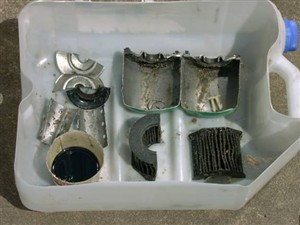"They put sugar in my tank!"
In thirty years of practice the most often repeated request for help comes from the automotive insurance adjusters. They find themselves faced with an auto engine that has suffered massive internal component failure from either neglect or excessive strain and an owner claiming sabotage with sugar in the fuel or oil.
On numerous occasions black, burnt smelling oil samples so thick from over heating that they had to be scooped from oil pans with spoons have been brought in to our office for testing. Frequently the sugar has been poured liberally into gas tanks and rocker arm covers usually after the engine has been totally destroyed. On occasion oil filters are removed and efforts made to spread the sugar crystals throughout the lubricating system just to add credibility to the claim. We have even had oil filters delivered to us sawn neatly in half, ostensibly to show how the sugar has spread through out the lubricating system.
We do exactly as the adjuster asks and test the oil or gasoline for its sugar content and we find exactly what we expect: nothing! Sugar is virtually insoluble in gasoline, diesel fuel and lubricating oils.
In the mid-1970's we examined samples brought to us by a large Ford dealership who had removed the materials from a new Thunderbird being repaired under warranty. Subsequent investigation brought out the following story.

The vehicle belonged to the owner of a construction company engaged in a bitter labour dispute. On the Friday afternoon preceding a long mid summer weekend the auto was parked near a picketed construction site in preparation for a trip north to a cottage. The vehicle was driven from the Kitchener-Waterloo area to Toronto and on to the North Bay area, being re-fuelled several times from reliable sources en route. On the Monday afternoon the owner returned home and first noticed the auto loosing power as he passed through Toronto. The power loss grew and half way between the big cities the car had to be driven onto the shoulder, finishing the journey behind a tow truck.
When examined in the repair shop, the engine would turn over occasionally fire but would not run. The spark plugs were coated with tar and removal of the heads revealed massive lumps of an oily black, sponge like solid with the sharp smell of burnt sugar. A gold coloured liquid drained from the fuel tank was identified as corn syrup. When cleaned up and refueled the undamaged engine started and ran as normal.
Syrup contamination was found in heavy equipment fuel tanks at the picketed site and had probably been added to the auto on the Friday. Water in the gasoline carried a small amount of sugar through the fuel filters into the combustion chambers where only a partial combustion took place. The now rich running engine began to "carbon-up" and it was only a matter of time before the deposits choked the life from the engine.
Old stories attribute this form of sabotage to the Dutch Resistance during the second world war. Sugar beets grown on the Dutch farms made sugar for their famous chocolates and beers. This innocent foodstuff when added to the fuel tanks of nazi occupation force vehicles, created havoc, hopefully in battle and far from the site of original attack were revenge would be difficult to exact.